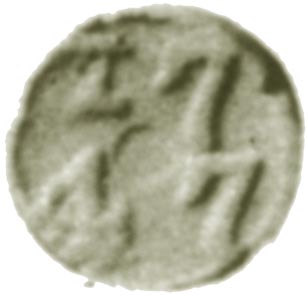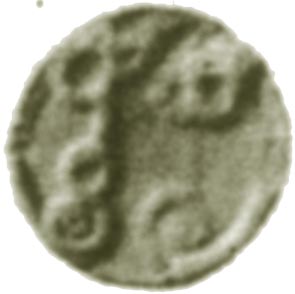


| 
| Oldest coin with Sinhala Text. No known specimen in Sri Lanka |
The oldest coin collection in Lanka is that of the Colombo National Museum. There are many smaller collections which are on display in many of the provincial museums run by the National Museums and the Archaeology Department. There are many Vihara which have displayed coins that have been gifted to them over many generations. Like at the Gangarama temple lots of these coins are most often displayed in basins with no numismatic classification or information.
Coins are very small items and one needs to use special display techniques to make visible the detail on them. It is often difficult to even identify the coin shown in most Lankan museum displays. Many have been wrongly labeled, reflecting the poor knowledge of the curators. Expertise on Lankan Numismatics is sadly lacking in both the Archaeology Dept. and National Museum. For reasons unknown they don't wish to consult collectors even after such help has been volunteered freely.
Coins are some of the oldest positively dateable items that can be collected. Public are allowed legally own ancient coins, but any over hundred years old are considered as antiques and cannot be exported. Recently I had the opportunity to look at the coins confiscated by the Sri Lanka Customs Dept. Among them were many coins less than 100 years old, and I was told the whole collection is confiscated if any antiques are detected. There were also many obviously modern replicas. The customs and even the Archaeology department do not appear to have the competence to recognize them, or the genuine coins have mysteriously transformed to replica over some years of storage.
Nearly all of the genuine coins at customs were very common. Copper massa coins of six Lankan Monarchs who ruled between 1197-1284 and Dutch VOC Duits from 1726-1796. These are found in such abundance, that they can be purchased in bulk for about Rs100 each, and few times this amount individually and when of higher grade. They are not important archaeologically and one wonders why Lanka should not allow them to go abroad, as they may excite some tourists to come and visit the island of origin.
Customs Dept. is in the process of constructing a small museum of confiscated items, in the new headquarters in Colombo Fort. It is a pity that this customs museum is not being made at the BIA in Katunayake. That would have been a far better venue to act as a deterrent to illegal export. If within the departure and transit area, it could also serve as an opportunity to educate passengers awaiting their flights of our culture and heritage.
The security of a collection is always a concern. Some of the most important and invaluable coins of the Colombo National Museum collection were stolen on the night of 2012 March 16th. In particular the rare Ada Kahavanu of which only 5 specimens are known is an irreplaceable loss. Probably the most valuable item stolen, its loss was hardly reported. None of the rare coins were recovered and "claim" to have been melted. A year after I investigated and wrote an official report on this collection, after the robbery for the CID, most of the critical recommendations, has not yet been implemented.
The Archaeology Department, documented a hoard 1048 Silver punch mark coins which are about 2000 years old in the 1986 Sinhala book Has Ebu Kahapana by M. H. Sririsoma. Only 16 remain and over 2 kg of silver has gone missing after Commissioner of Archaeology Sirisoma, passed away in 1992. Twenty years later the secure inventory control is still not in place.
Items in collections are not only lost but can also be damaged by incompetence. Most coins in the Museum collection have been glued to the display, ruining one side of an otherwise mint condition coin. Same has been done at the Central Bank (CBSL) museum for banknotes, some worth many millions.
The CBSL had a nice little museum in Rajagiriya, with banknotes framed on the walls and coins arranged in table top cases. Few years ago CBSL did a major renovation and more than doubled the floor area, but unfortunately now display less than half of the original collection. One of the poor designs was to try display coins on vertical panels, and to use the tables to display currency. Few months after opening the effect of gravity was apparent with many of the coins had dropped to the bottom of the panels. The Central Banks has smaller collection on display in the Branch offices, but has just shown images for some of even the most common coins. I assume they are awaiting donations from the public.
Many Local Banks have, time and again put coins and currency on display. However most of these museums have now been closed from public display. This is mainmainly due to the lack of funds and or interest of those who take over from the officer who proposed and established the museum with a lot of care and enthusiasm. The museums at the National Savings Bank and the Peoples bank are examples. There is a small collection in the Hatton Nation Bank headquarters, which opened few years ago which is not well publicized.
The Bank of Ceylon (BoC) opened a museum in 1989 for their 50th Anniversary, which included a collection of coins and currency loaned to them by Mr Fred Medis. Around 2002 this collection moved from Bristol Street to the 28th floor of the BoC Tower and since then opens only by prior arrangement.
A new and larger BoC museum is being planned to be opened in time for their 75th Anniversary in 2014 in active consultation with the Sri Lanka Numismatic Society (SLNS), and coordinated by a museologist. This will hopefully prevent the errors seen at other locations. BoC hopes to keep this museum open to the public, and have a small lecture hall and archival area to promote the study of Numismatics. Located on the 28th floor of the BoC Tower, which also has an open balcony with breathtaking view of the Colombo City and Harbor, it will surely become a popular destination of both School children and Tourists.
Most large collections get unfortunately sold at Auction after the lifetime of a collector. Dual custody of an insured loan and display in a public institution with ownership retained by the family may, ensure that a collection will remain together over the longer term.
Writer maintains an educational website on Lankan coins at coins.lakdiva.org.lk, and is President of SLNS.